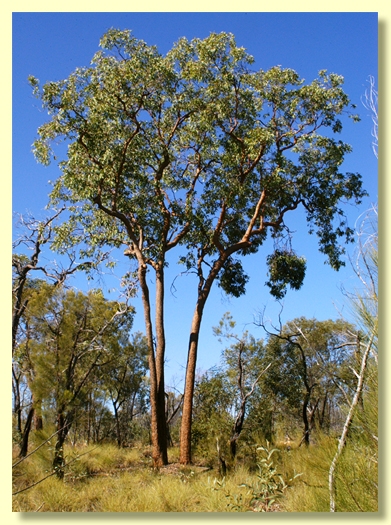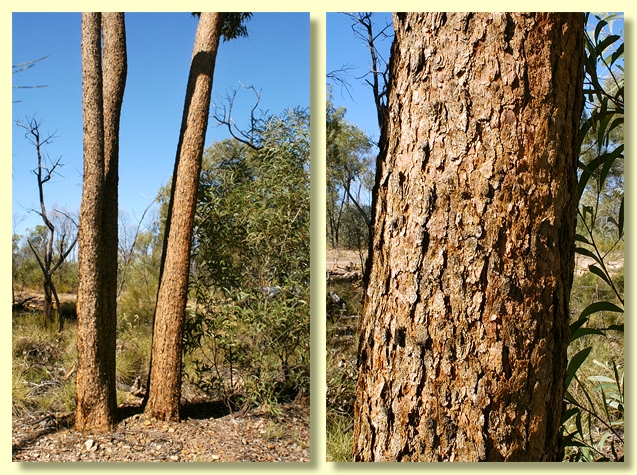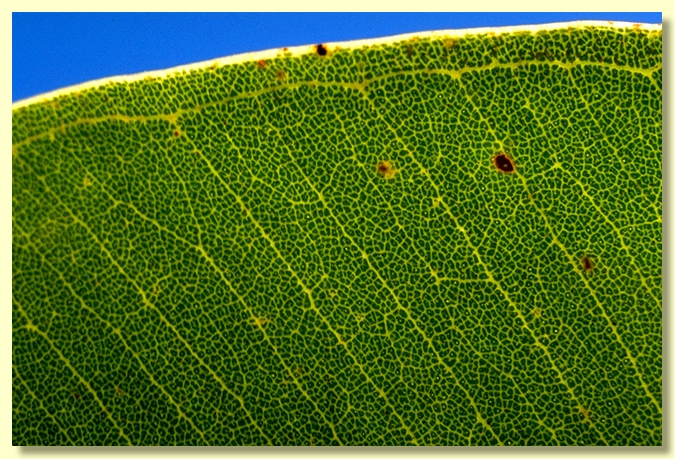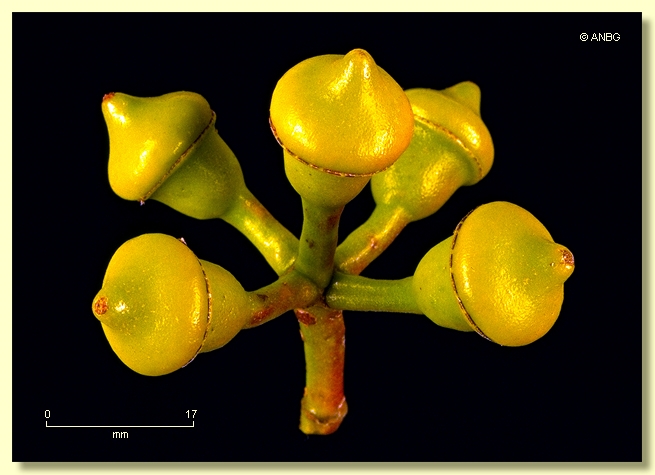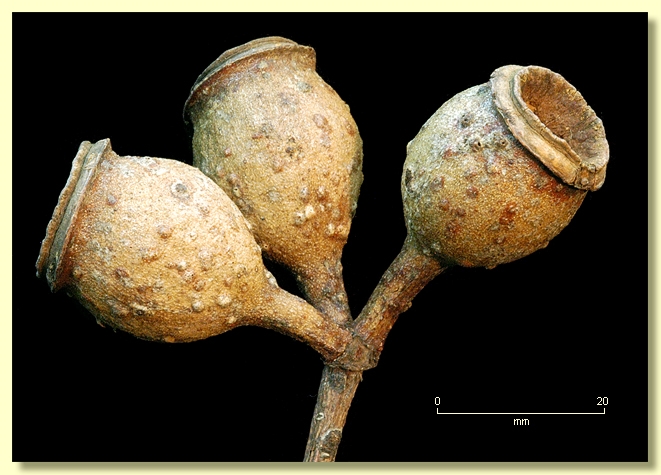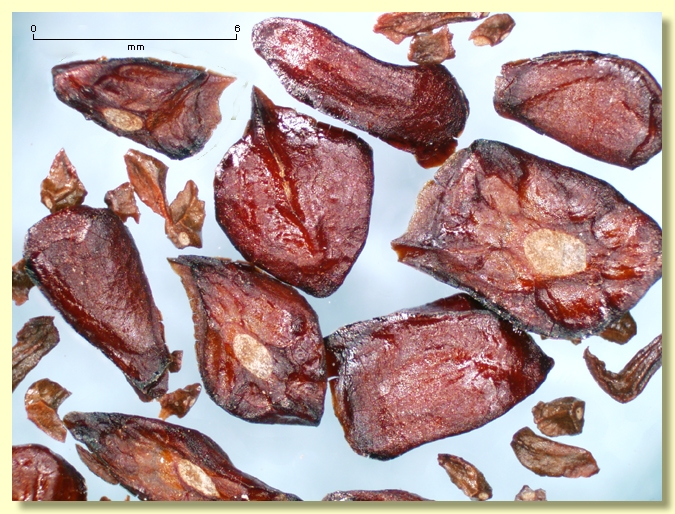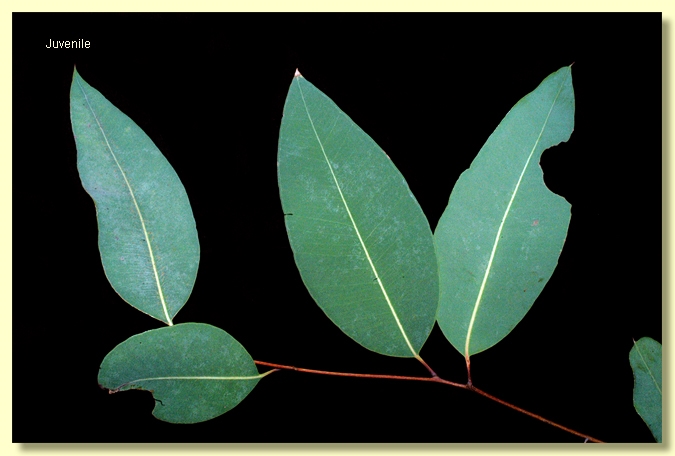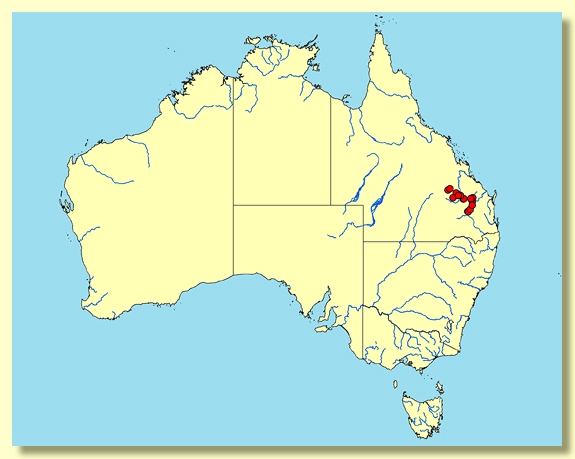Euclid - Online edition
Corymbia watsoniana subsp. watsoniana
Corymbia | Ochraria
Tree to 15 m tall, rarely 20 m. Forming a lignotuber.
Bark rough to the smallest branches, thick, soft, loosely flaky to tessellated, yellow-brown to yellow-grey over orange-brown.
Branchlets smooth (glabrous); pith sometimes contains ± elongated oil bodies.
Juvenile growth (coppice or field seedlings to 50 cm): stem rounded to square in cross-section, smooth i.e. glabrous; juvenile leaves always petiolate, alternate, ovate to lanceolate, 11.5–21 cm long, 5–9.5 cm wide, base rounded or truncate at lower nodes then tapering (peltate leaf bases usually absent), apex pointed, green, concolorous, dull, lowest leaves slightly scabrid along main veins but subsequent leaves glabrous.
Crown entirely of glabrous Adult leaves; leaves alternate, petiole 1.3–4 cm long; blade ovate to broadly lanceolate or falcate, 9–21.5 cm long, 1.8–6.5 cm wide, flat or slightly undulate, base tapering to petiole, apex finely pointed, margin entire, concolorous, dull, bright green to grey-green, penniveined, densely to very densely reticulate, intramarginal vein parallel to and just within margin, oil glands island, small, numerous, 1 per areole or obscure.
Inflorescence terminal compound, peduncles 0.9–4.5(5.5) cm long, buds 7 per umbel, pedicels 0.4–1.8 cm long. Mature buds obovoid with operculum wider than base of bud, 1.5–2 cm long, 1.2–1.7 cm wide, sometimes slightly ridged, scar present (outer operculum shed early), flattened to rounded and apiculate or umbonate, or beaked, stamens inflexed, anthers ± oblong, versatile, dorsifixed, dehiscing by longitudinal slits (non-confluent), style long, stigma blunt or tapered, locules 3, the ovules arranged in 7 or 9 ± vertical rows on the placentae or the rows indistinct, Flowers creamy white.
Fruit shortly pedicellate (pedicels 0.2–1.5 cm long), barrel-shaped to urceolate or ± cylindrical, 2–3.2 cm long, 1.8–2.4 cm wide, disc descending, valves 3, enclosed.
Seeds brown to reddish brown and shiny, 3–8.5 mm long, boat-shaped with a keel on the smooth and usually cracked dorsal surface but sometimes the keel lacking, not winged but some seed have a short flange at one end, hilum ventral.
Cultivated seedlings (measured at ca node 10): cotyledons reniform to orbicular; stems square in cross-section, setose for 2 or 3 nodes only; leaves always petiolate, opposite for 2 or 3 nodes then alternate, ovate to ovate-lanceolate, 10–13 cm long, 4–6 cm wide, base peltate only at lower nodes (sometimes no leaves peltate) soon becoming rounded, margin entire, apex pointed, dull, green, setae present only on main veins and petioles of leaves at nodes 2 and 3 then glabrous.
Flowering has been recorded in June.
Corymbia watsoniana is a yellow bloodwood tree species endemic to central Queensland and distributed in the area from Springsure and Rolleston south-east to Eidsvold and near Gayndah, and south to Barakula State Forest. It is a component of dry sclerophyll woodlands on sandy soils in sandstone areas. It has yellowish flaky to tessellated soft rough bark throughout and dull green to grey-green crown of glabrous adult leaves, terminal inflorescences and relatively large fruit. The juvenile leaves vary depending on the subspecies.
There are two subspecies:
C. watsoniana subsp. watsoniana
Has buds with the operculum consistently wider than the hypanthium (base of bud), fruit >1.7 cm wide and juvenile leaves essentially non-setose and not peltate. It occurs from Wigton (S of Gayndah) west to Robinson and Isla Gorges near Theodore, with outliers to the north at Blackdown Tableland, and to the south in the Chinchilla–Pelican area where it occurs in Barakula State Forest.
C. watsoniana subsp. capillata
This subspecies is distinguished from subsp. watsoniana primarily on the juvenile leaves, which are peltate and hairy for many nodes in coppice growth; fruit are somewhat shorter and narrower than in subsp. watsoniana but with some overlap in both dimensions. Buds have opeculum wider than the hypanthium at maturity, but during development this may not be apparent. It is restricted to the Expedition Range and Staircase Range near Rolleston.
The large buds and fruit separate this species from all other yellow bloodwoods, as does the operculum being wider than the hypanthium when fully developed.
MORE ABOUT CORYMBIA
MORE ABOUT YELLOW BLOODWOODS
Corymbia watsoniana: after Thomas Wentworth Watson, who collected the type specimen in 1876 and sent it to Mueller in Melbourne. Nothing further is known about Watson.
subsp. capillata: Latin capillatus, hairy, referring to the setose seedling growth.

